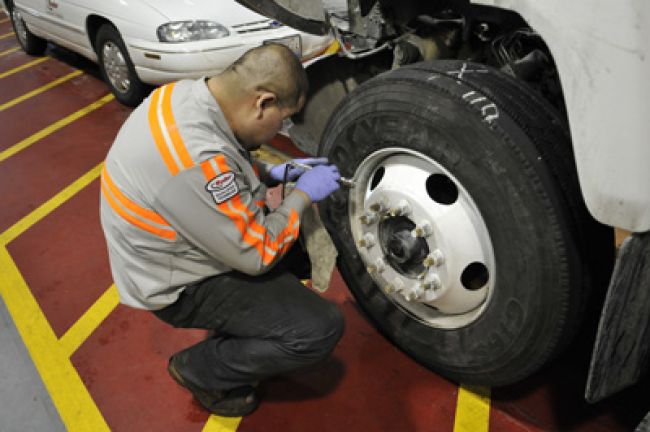
How to Maximize the Tire Life of Medium-Duty Trucks
Because every fleet is different, what you spend on tires is going to be unique for your operation. One thing is certain, however: No matter what your operation, tires are going to make a significant contribution to your cost of doing business. Because of that fact, it’s important for fleet professionals to do everything possible to minimize the cost of every 32nd of an inch of tread rubber they purchase.
Spec Tires Designed for Long Life
Although radials dominate the tire market in every commercial application, there are still some fleets using bias-ply designs. It’s not the original price that should be considered when buying tires; what’s important is the total cost per mile the product delivers before it’s scrapped. And a radial will win that contest every time.
There is less rolling resistance and heat generated as a radial rolls down the road because of its steel-supported tread and casing. This results in better fuel economy, longer casing life and lower cost per lifetime mile than bias-ply designs. Radials also offer bonuses of better road handling, improved driver comfort and less downtime.
Maintain Optimal Air Pressure at All Times
After any tire is put into operation, ongoing maintenance is required to maximize its service life, and air pressure is the most critical tire maintenance factor. Operating with an underinflated tire will cause heat buildup in the casing, leading to shortened casing life, irregular tread wear and possible sudden tire destruction. These possibilities make it imperative to perform regular pressure checks. Air will migrate through the walls of every tire, causing them to lose pressure over time. Lost air must be regularly replaced.
Inflation pressures should be checked with calibrated tire gauges – not tire billies – at least weekly and definitely before any long trips. Check pressures when tires are cold; early morning is normally a good time. Even a short trip will cause heat buildup and a pressure increase. Remember, never bleed air from a hot tire.
When tire inflation pressures are being checked, it’s also a perfect time to inspect those same tires. If a regular pressure check finds that a tire has lost 4 psi, look for something that could have caused such a loss – valve leakage, tread penetration or rim damage, for example. You should consider any tire to be flat if it is found to be 20 percent below its desirable air pressure, and it should be removed from service as should any tire with a bulge, crack or cut.
Ensure Timely Vehicle Inspection and Maintenance Intervals
While both underinflation and overinflation can cause rapid tread wear, most tire wear problems can be traced to the vehicle’s condition. Alignment refers to more than steering axle geometry. Total vehicle alignment also addresses the tracking of all axles on the vehicle to include any trailer axles. The Technology & Maintenance Council of the American Trucking Associations (www.trucking.org/technology_council.aspx) has established recognized standards for vehicle alignments in its Recommended Practice 642.
Regular vehicle alignment checks included in a preventive maintenance program will help to minimize tire costs and help control fuel consumption. Consider including vehicle alignment checks:
• Upon delivery of new vehicles.
• At a vehicle’s first maintenance check.
• When new steer tires or front-end components are installed.
• When tire wear suggests a problem.
Tires are expensive for any fleet, but attention to both tire and vehicle maintenance will not only help in minimizing your tire cost per mile, it will also help to increase your fuel economy.
About the Author: Tom Gelinas is a U.S. Army veteran who spent nearly a decade as a physicist before joining Irving-Cloud Publishing Co. While at Irving-Cloud, he worked in various editorial capacities for several trade publications including Fleet Equipment, Heavy Duty Equipment Maintenance and Transport Technology Today. Gelinas is a founding member of Truck Writers of North America, a professional association, and a contributing writer for Utility Fleet Professional.

